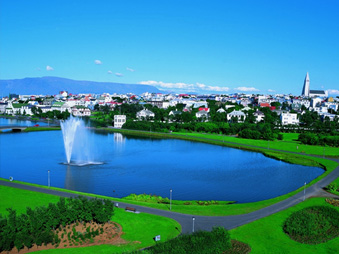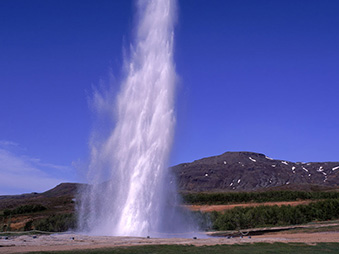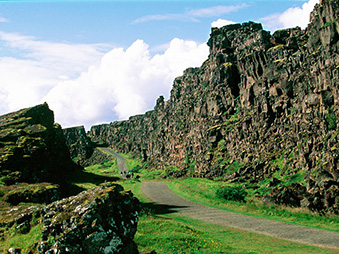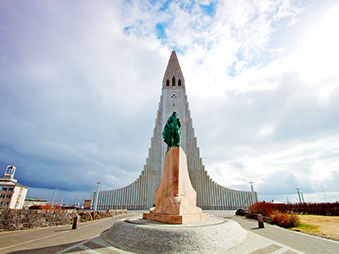-

- Reykjavík
Reykjavík is the capital and largest city of Iceland. Its latitude, at 64°08' N, makes it the world's northernmost capital of a sovereign state. It is located in southwestern Iceland, on the southern shore of the Faxaflói Bay. With a population of around 120,000 (and over 200,000 in the Greater Reykjavík Area), it is the heart of Iceland's cultural, economic and governmental activity.
Reykjavík is believed to be the location of the first permanent settlement in Iceland, which Ingólfur Arnarson is said to have established around AD 870. Until the 18th century, there was no urban development in the city location. The city was founded in 1786 as an official trading town and grew steadily over the next decades, as it transformed into a regional and later national centre of commerce, population, and governmental activities. It is among the cleanest, greenest, and safest cities in the world.
-

- Gullfoss
Gullfoss "Golden Falls is a waterfall located in the canyon of Hvítá river in southwest Iceland.
Gullfoss is one of the most popular tourist attractions in the country. The wide Hvítá rushes southward. About a kilometre above the falls it turns sharply to the right and flows down into a wide curved three-step "staircase" and then abruptly plunges in two stages (11 m and 21 m) into a crevice 32 m (105 ft) deep. The crevice, about 20 m (60 ft) wide, and 2.5 km in length, extends perpendicular to the flow of the river. The average amount of water running over this waterfall is 140 m³/s in the summertime and 80 m³/s in the wintertime. The highest flood measured was 2000 m³/s.
Together with Þingvellir and the geysers of Haukadalur, Gullfoss forms the Golden Circle, a popular day tour for tourists in Iceland.
-

- Geysir
Geysir sometimes known as The Great Geysir, is a geyser in southwestern Iceland. It was the first geyser described in a printed source and the first known to modern Europeans. The English word geyser (a spouting hot spring) derives from Geysir. The name Geysir itself is derived from the Icelandic verb geysa, "to gush", the verb from Old Norse. Geysir lies in the Haukadalur valley on the slopes of Laugarfjall hill, which is also the home to Strokkur geyser about 50 metres south.
Eruptions at Geysir can hurl boiling water up to 70 metres in the air. However, eruptions may be infrequent, and have in the past stopped altogether for years at a time.
-

- Þingvellir
Þingvellir is a place in Bláskógabyggð in southwestern Iceland, near the peninsula of Reykjanes and the Hengill volcanic area. Þingvellir is a site of historical, cultural, and geological importance and is one of the most popular tourist destinations in Iceland. It is the site of a rift valley that marks the crest of the Mid-Atlantic Ridge. It is also home to Þingvallavatn, the largest natural lake in Iceland.
Parliament was established at Þingvellir in 930 and remained there until 1798.Þingvellir National Park was founded in 1930 to protect the remains of the parliament site and was later expanded to protect natural phenomena in the surrounding area. Þingvellir National Park was the first national park in Iceland and was decreed "a protected national shrine for all Icelanders, the perpetual property of the Icelandic nation under the preservation of parliament, never to be sold or mortgaged.
-

- Blue Lagoon
Blue Lagoon is one of Iceland’s most popular attractions, a natural geothermal pool in the middle of a large and dramatic lava field and an oasis that owes its existence to a nearby geothermal power plant, looming large over the aqua tinted waters. We stop for 1 ½ hour for a refreshing bathe or a swim in the inviting, rejuvenating and pleasantly warm mineral-rich water (36°C-38°C), reputed for its healing properties.(Entrance included) An indoor pool and geothermal sauna are also on the site. Bathing in this surreal environment is a unique experience no one should miss. The Blue Lagoon’s warm water and natural active ingredients like mineral salts, silica and blue green algae help you relax and escape the stress and strain of daily life.
-

- Hallgrímskirkja
Hallgrímskirkja is a Lutheran (Church of Iceland) parish church in Reykjavík, Iceland. At 73 metres (244 ft), it is the largest church in Iceland. State Architect Guðjón Samúelsson's design of the church was commissioned in 1937. He is said to have designed it to resemble the basalt lava flows of Iceland's landscape.[3] It took 38 years to build the church. Construction work began in 1945 and ended in 1986, the landmark tower being completed long before the church's actual completion. Situated in the centre of Reykjavík, it is one of the city's best-known landmarks and is visible throughout the city. The church is also used as an observation tower. An observer can take a lift up to the viewing deck and view Reykjavík and the surrounding mountains.








